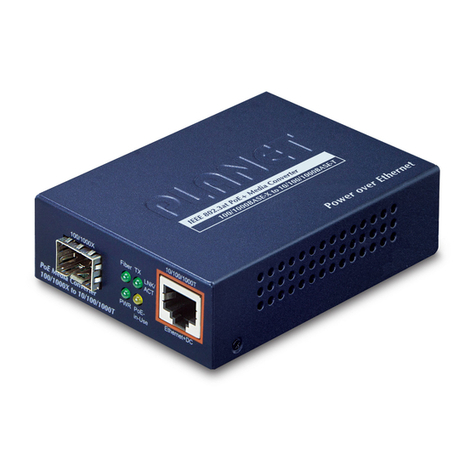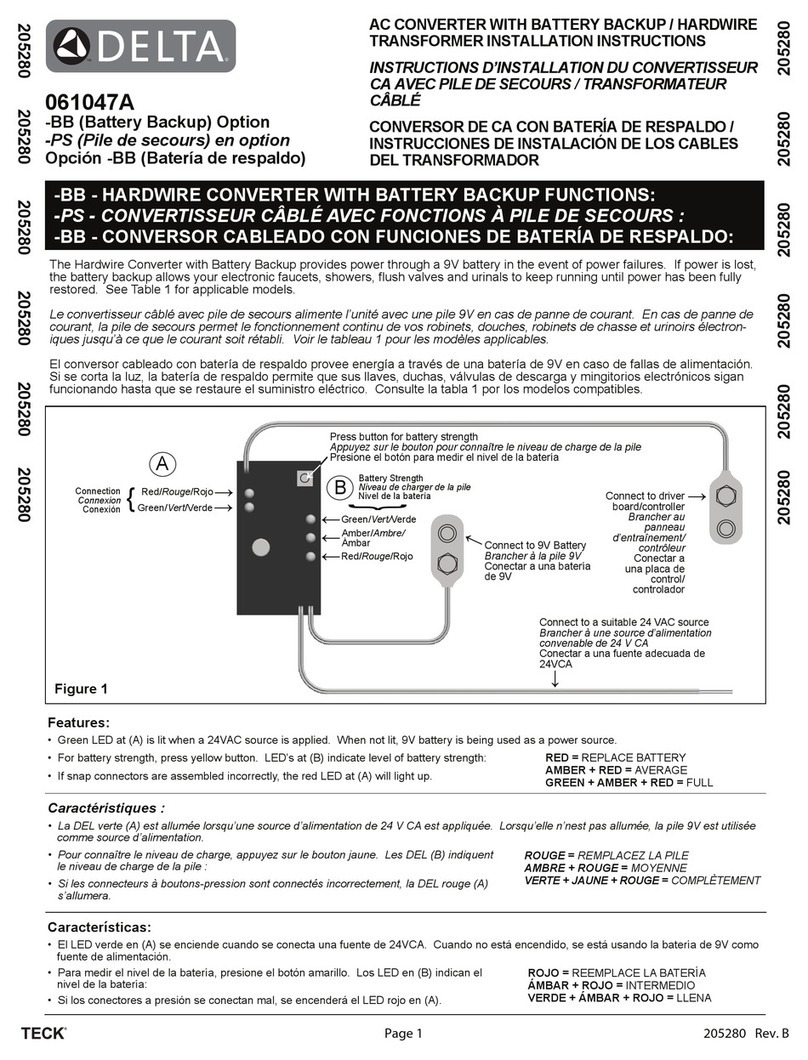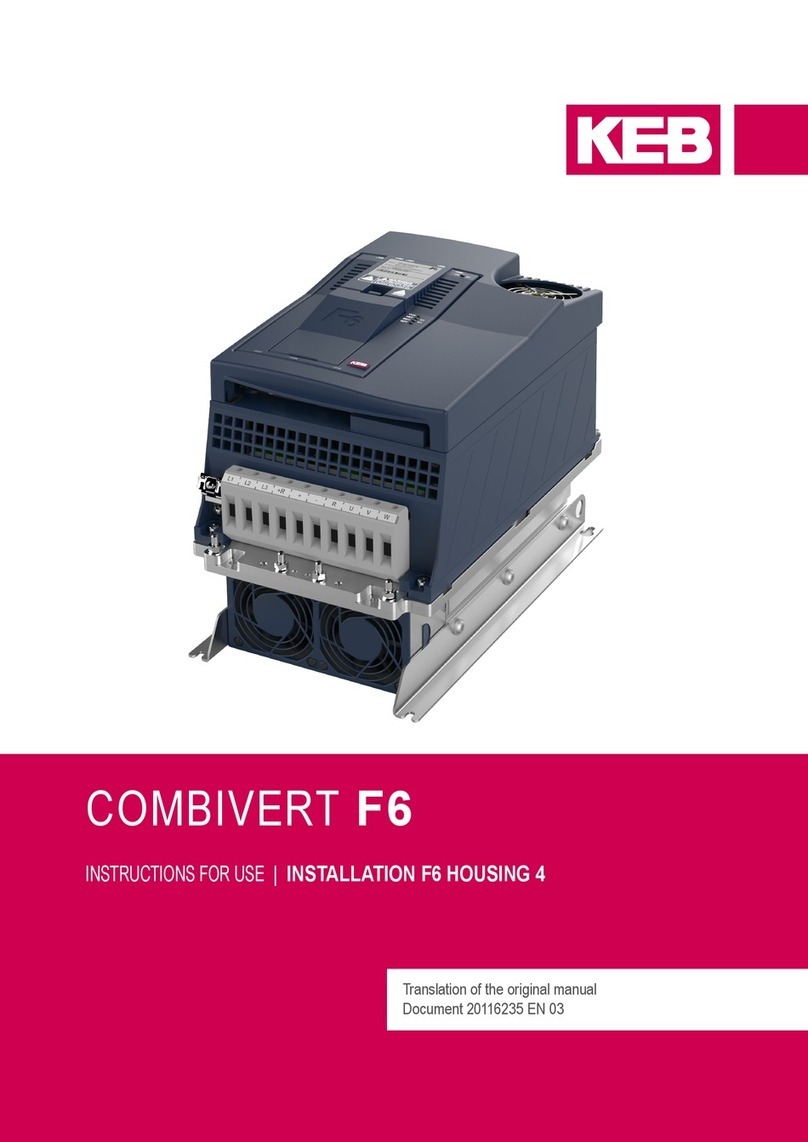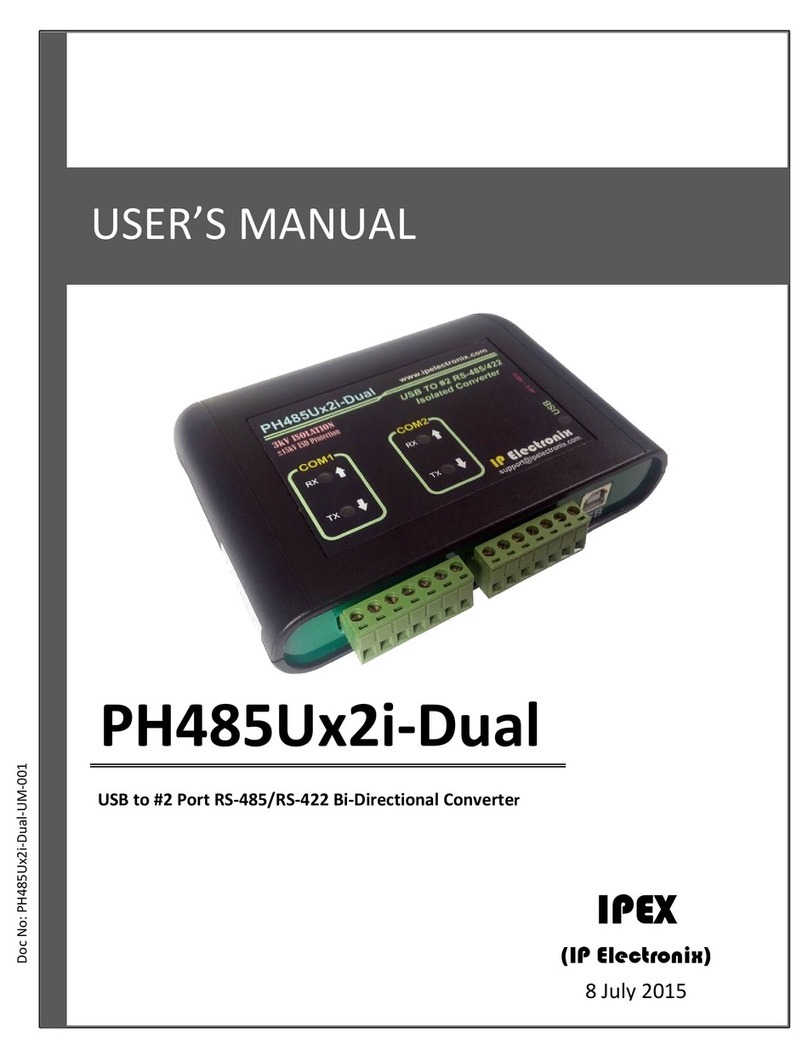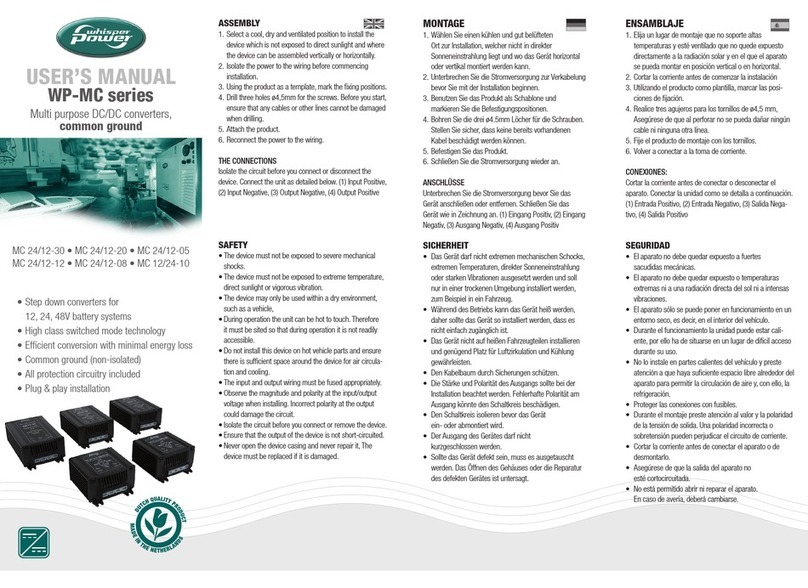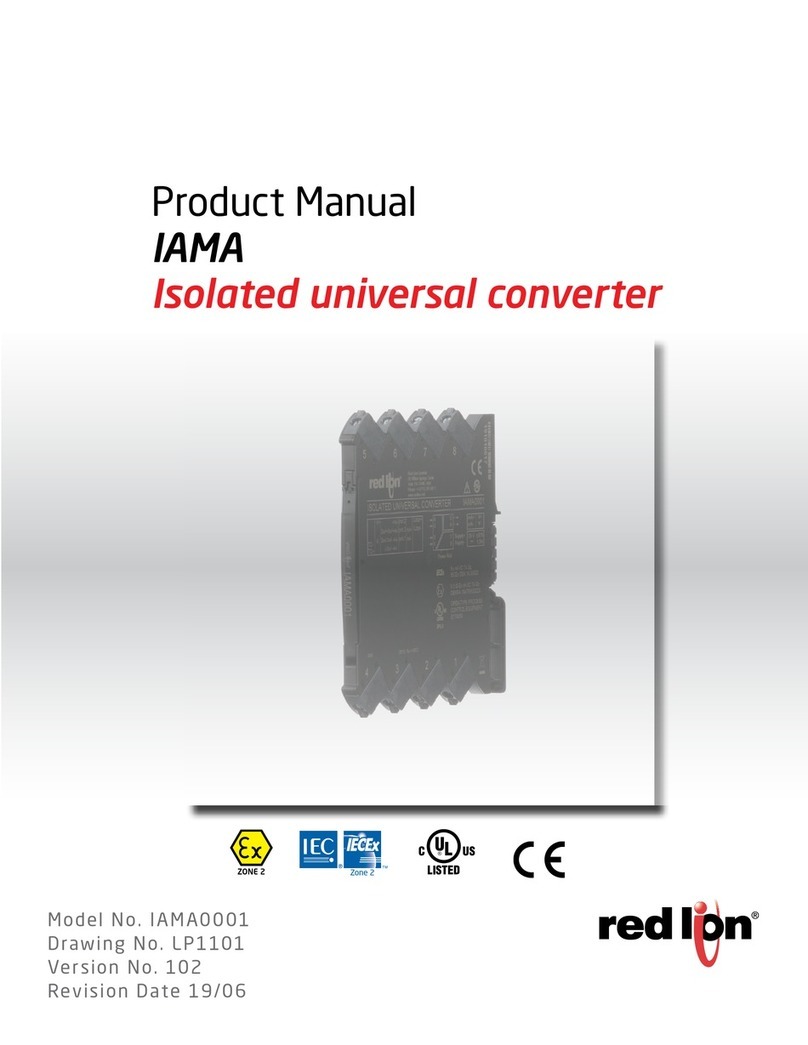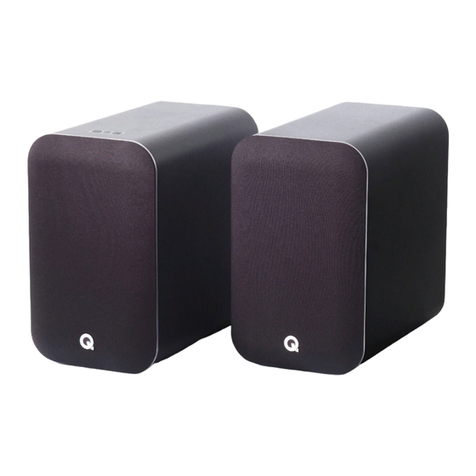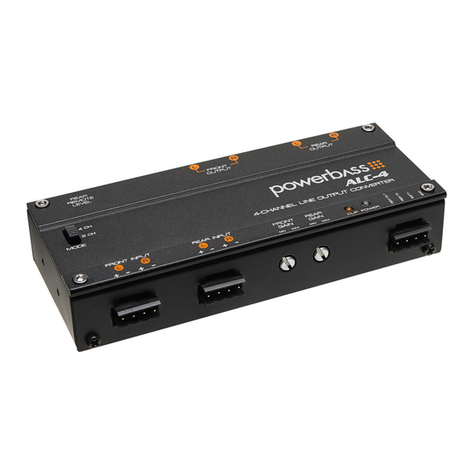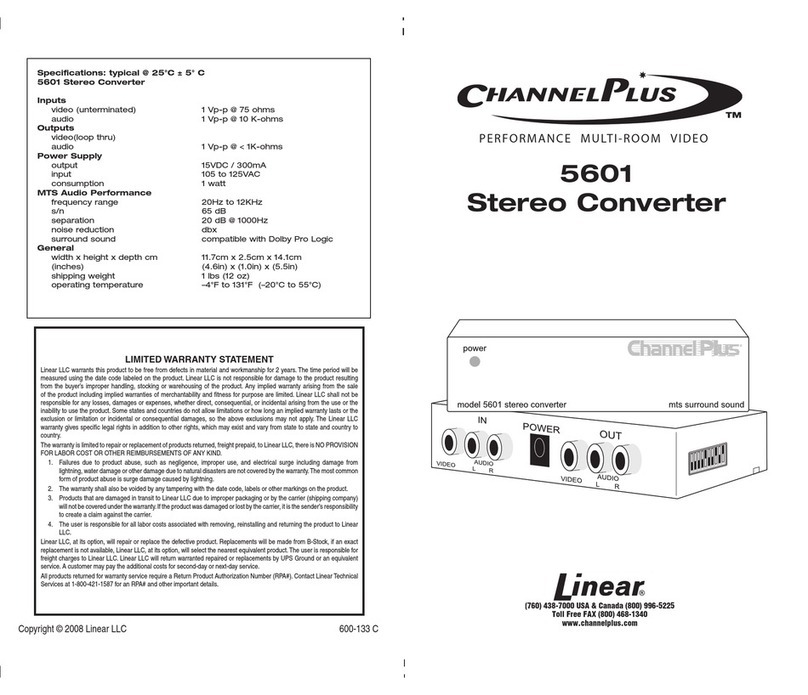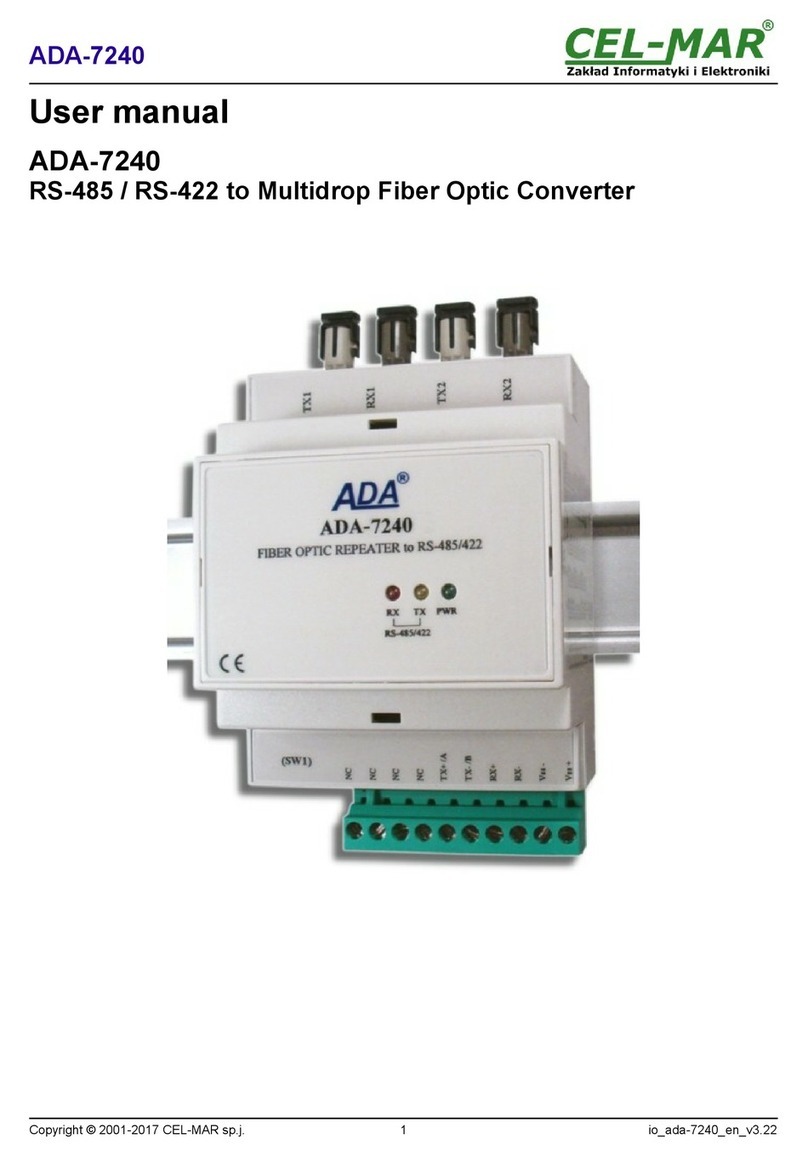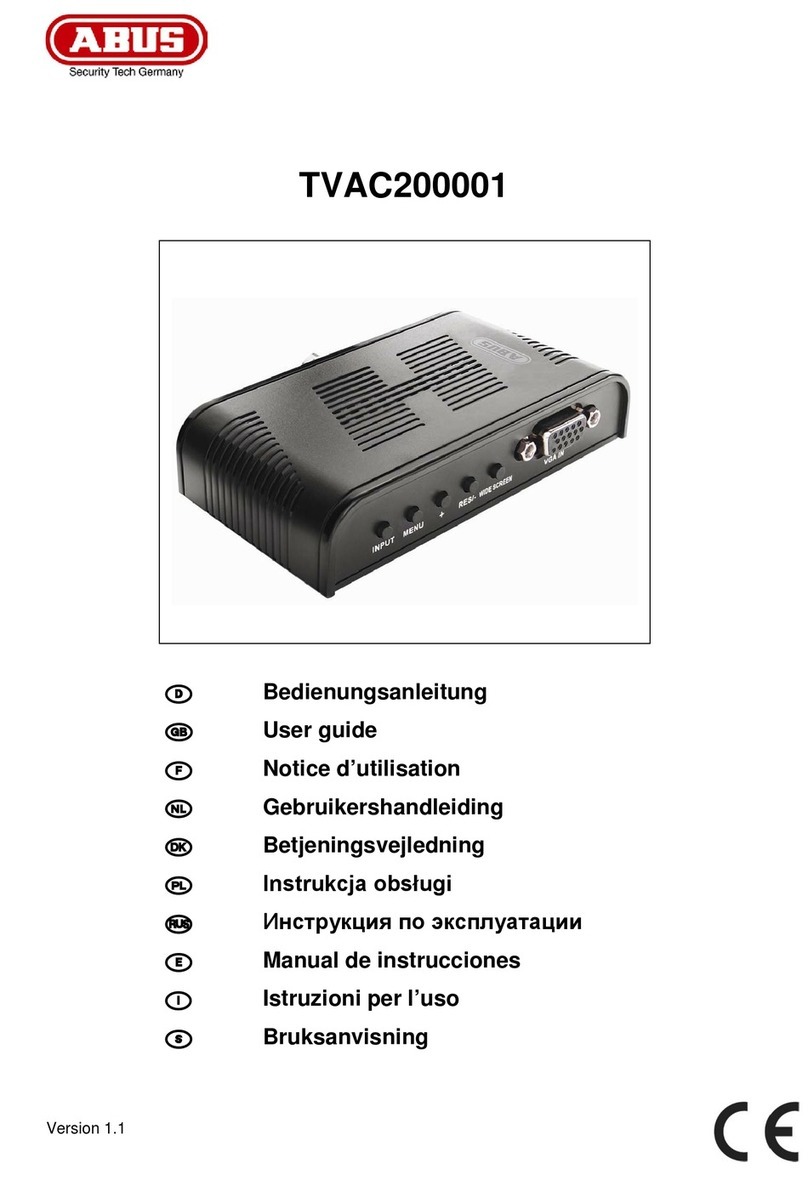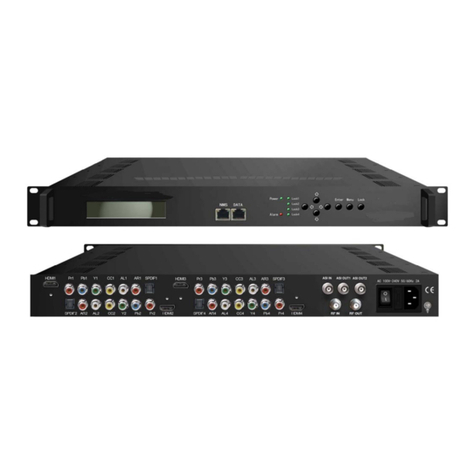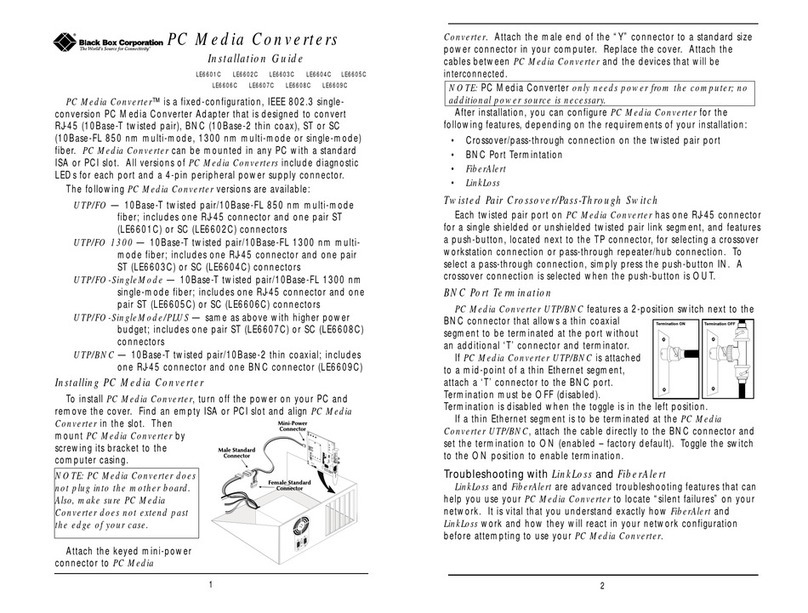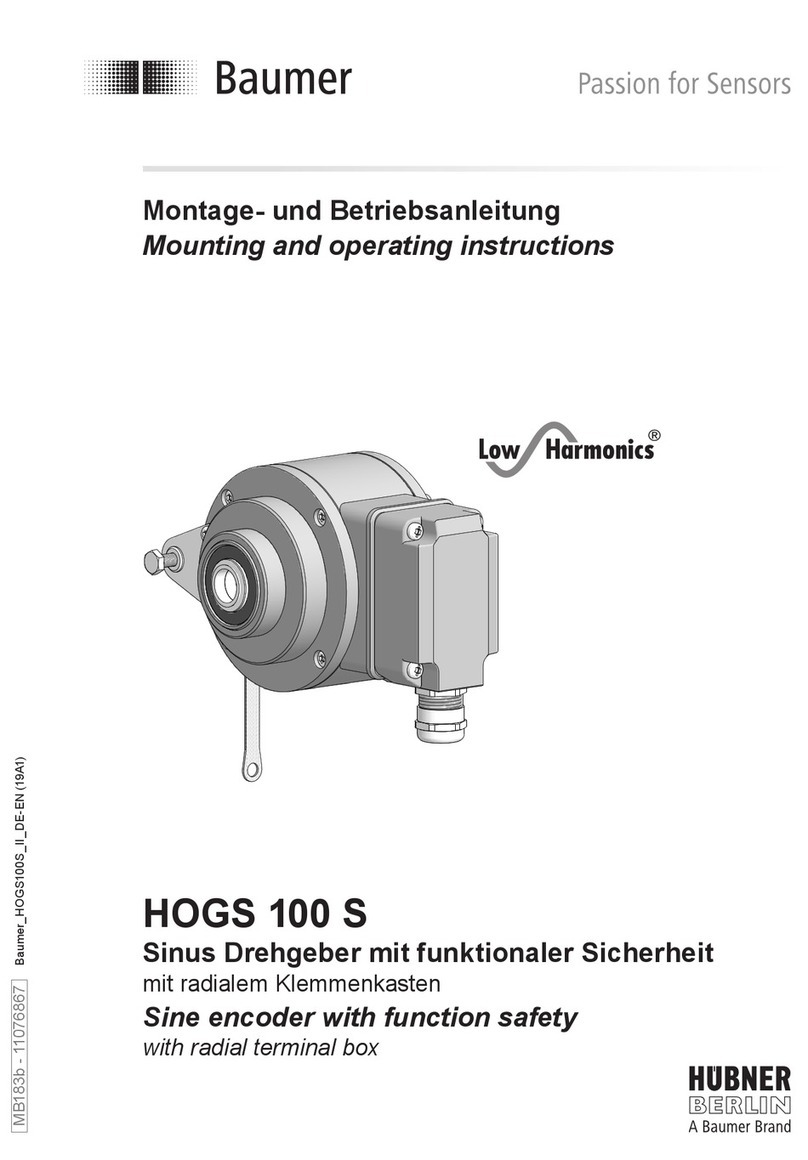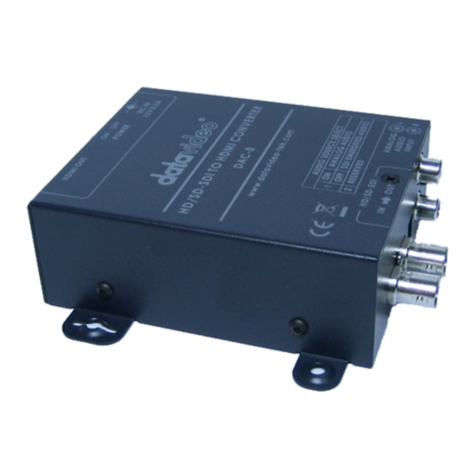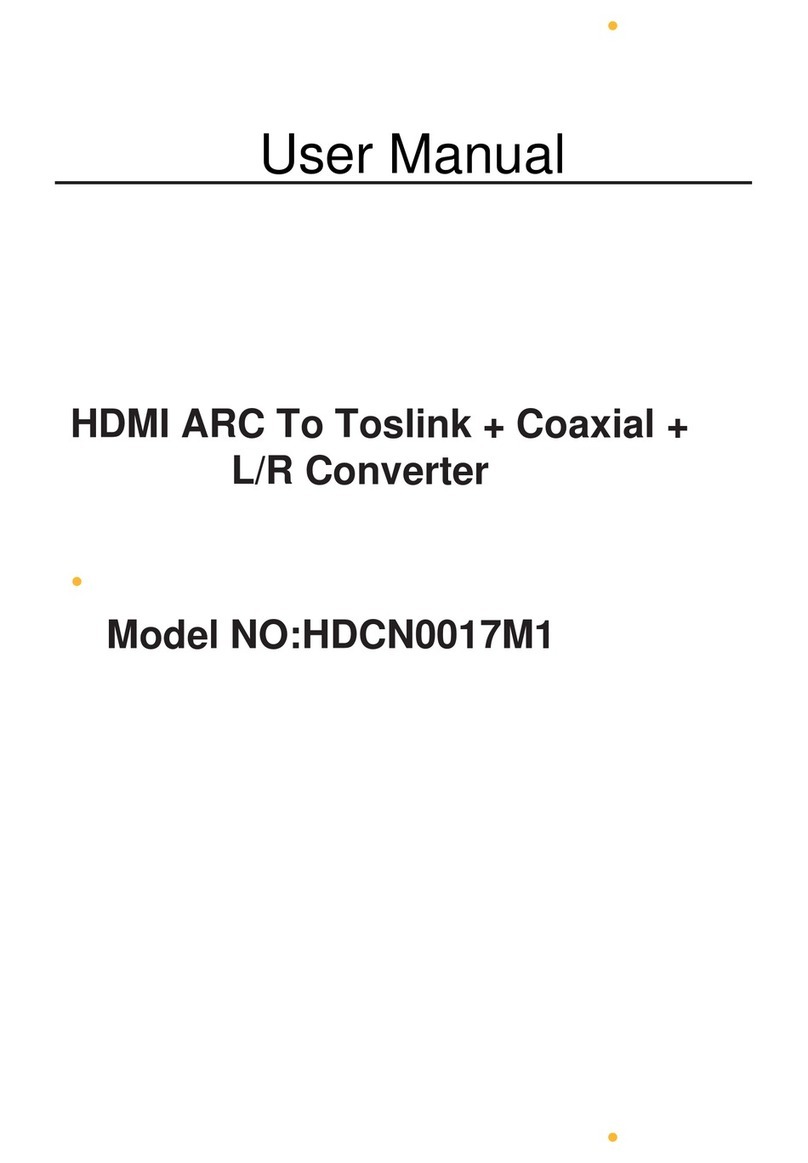Johnson Controls Tyco PowerG PG8HRDW8 User manual

*29011147R001*
PG8HRDW8 and PG9HRDW8 IQ
Hardwire PowerG Wired to Wireless
Converter Installation Manual
29011147R001

2 PG8HRDW8 and PG9HRDW8 IQ Hardwire PowerG Wired to Wireless Converter Installation Manual

Contents
ContentsSafety instructions............................................................................................................................................5
Introduction...................................................................................................................................................... 6
Technical Specifications...................................................................................................................................7
Installing the module.......................................................................................................................................9
Mounting the module......................................................................................................................... 10
Mounting the enclosure............................................................................................................................10
Mounting the power adapter................................................................................................................... 10
Wiring the zones.................................................................................................................................. 12
Normally open and normally closed wiring............................................................................................12
Single end-of-line resistors....................................................................................................................... 13
Double end-of-line resistors..................................................................................................................... 14
Wiring programmable outputs..........................................................................................................15
Wiring a fire zone to the PGM2 configured as a 2-wire loop................................................................17
Wiring a 4-wire smoke, heat, or CO detector..........................................................................................19
Wiring auxiliary power........................................................................................................................ 20
Wiring the bell output......................................................................................................................... 20
Installing the battery...........................................................................................................................20
Wiring the module...............................................................................................................................21
Wiring the power supply........................................................................................................................... 22
Wiring the battery...................................................................................................................................... 22
Wiring a keypad/HSM2108/HSM2300......................................................................................................23
Enrolling the module..................................................................................................................................... 25
Testing the module placement.......................................................................................................... 25
Enrolling wired zones automatically............................................................................................................26
Enrolling a keypad/zone expander/power supply.....................................................................................27
Attaching the cover........................................................................................................................................28
Status LEDs......................................................................................................................................................29
Troubleshooting............................................................................................................................................. 30
Wiring diagram...............................................................................................................................................31
FCC and ISED Canada Information.............................................................................................................. 32
Modification statement.......................................................................................................................32
Interference statement.......................................................................................................................32
Wireless notice..................................................................................................................................... 32
FCC class B digital device notice...................................................................................................................33
UL and ULC notes...........................................................................................................................................34
UL commercial and residential installation requirements and considerations...........................34
UL commercial, UL household, and ULC security level I and II burglar alarm unit.....................34
UL and ULC household fire warning system....................................................................................34
European CE Compliance and CERTALARM Certification.......................................................................... 35
Simplified EU declaration of conformity........................................................................................... 35
PG8HRDW8 and PG9HRDW8 IQ Hardwire PowerG Wired to Wireless Converter Installation Manual 3

EULA.................................................................................................................................................................36
SOFTWARE PRODUCT LICENSE.......................................................................................................... 36
Limited warranty............................................................................................................................................ 39
International Warranty....................................................................................................................... 39
Warranty Procedure............................................................................................................................ 39
Conditions to Void Warranty.............................................................................................................. 39
Items Not Covered by Warranty........................................................................................................ 39
Disclaimer of Warranties.................................................................................................................... 40
Out of Warranty Repairs.....................................................................................................................40
Trademark.......................................................................................................................................................41
PG8HRDW8 and PG9HRDW8 IQ Hardwire PowerG Wired to Wireless Converter Installation Manual4

Safety instructions
Read the safety information before you install the equipment.
Important: This equipment must be installed by a skilled person only. A skilled person is an
installer with appropriate technical training. The installer must be aware of potential hazards
during installation and measures available to minimize risks to the installer and other people.
• Before you install this equipment, disconnect all power sources (for example mains, battery,
and telephone line) connected to the alarm panel.
• Install the equipment indoors in a non-hazardous environment where the following
conditions are met:
- Pollution degree - Maximum 2
- Over voltages - Category II
• Internal wiring must be routed to prevent strain on wire and terminal connections, loose
terminal connections, and damage to conductor insulation.
• Instruct the user that there are no user serviceable parts in this equipment. All equipment
must be serviced by a skilled person.
• Skilled persons are persons who have training or experience in the equipment technology,
particularly the various energies and energy magnitudes used in the equipment. Skilled
persons are expected to use their training and experience to recognize energy sources
capable of causing pain or injury and to take action for protection from injury. Skilled persons
are persons who have training or experience in the equipment technology, particularly the
various energies and energy magnitudes used in the equipment. Skilled persons are expected
to use their training and experience to recognize energy sources capable of causing pain or
injury and to take action for protection from injury.
5PG8HRDW8 and PG9HRDW8 IQ Hardwire PowerG Wired to Wireless Converter Installation Manual

Introduction
The IQ Hardwire PowerG Wired to Wireless Converter converts existing hardwired zones to PowerG
wireless zones.
There are two models, the PG8HRDW8 and PG9HRDW8, and each provide eight hardwired zones
and four programmable outputs. This document describes how to mount the enclosure, wire zones,
connect the battery, enroll devices, and troubleshoot.
Note: Only PG9HRDW8 is UL and ULC listed. For UL and ULC installations, use this device only
in conjunction with compatible wireless receiver and control panel combinations, model Qolsys
IQPanel2 and IQPanel4.
Before you begin, make sure that the kit contains the following items:
• The plastic enclosure containing the IQ Hardwire PowerG Wired to Wireless Converter
• The transformer
• The hardware pack
The following table outlines panel compatibility
Table 1: Panel compatibility
Module Supported by
v1.2 IQ2 plus panel v2.7.0 / IQ4 v4.1
PG8HRDW8 and PG9HRDW8 IQ Hardwire PowerG Wired to Wireless Converter Installation Manual6

Technical Specifications
The following table outlines the electrical ratings of the components of the IQ Hardwire PowerG
Wired to Wireless Converter.
Table 2: Technical specifications
Type Description
DC input voltage and current Use the provided external power adapter with the following
ratings.
Input for UL and ULC applications: 120 VAC, 60 Hz, 1.2A
Input for EN50131 applications: 240 VAC (+10%, -15%), 50
Hz, 1.2 A
Output: 18 VDC, 2.22 A
Manufacturer: ShenZhen SOY Technology Co. Ltd.
UL and ULC Model: SOY-1800222US
DSC UL and ULC part number: PGWLSH40A, HS40WPSA and
HS40WPSNA
EN model: SOY-1800222-EU
DSC UL and ULC part number: HS40WPSA & HS40WPSNA
DSC EN part number: PGWLSH40C
Battery type Sealed, rechargeable lead acid
Battery charging voltage and
current
13.7 VDC, 360 mA
Low battery threshold 11.4 VDC
Battery cutoff level 9.6 VDC ± 2%
PCB assembly current consumption 70 mA
Standby battery Only use the battery rated 12 VDC/ 7 Ah
The energy level of the battery when it is charged is 100%
24-hour standby time and 5-minute alarm time for UL and
ULC residential fire applications and ULC Security Level II
applications.
Note: The AUX current must not exceed 180 mA.
24-hour standby time and 5-minute alarm time for UL and
ULC residential fire applications and 12-hour CO alarm.
Note: The AUX current must not exceed 110 mA.
4-hour standby time and 5-minute alarm time for UL and
ULC residential burglary applications.
Note: The AUX current must not exceed 700 mA.
4-hour standby time and 15-minute alarm time for UL
commerical burglary applications.
Note: The AUX current must not exceed 700 mA.
Note: For EN50131 Grade 2 applications, the devices provide
12 hours of standby time and recharge in 72 hours. The AUX
current load must not exceed 430 mA.
7PG8HRDW8 and PG9HRDW8 IQ Hardwire PowerG Wired to Wireless Converter Installation Manual

Table 2: Technical specifications
Type Description
Bell circuit voltage and current 11.3 VDC to 12.5 VDC, maximum current 700 mA
continuous. For EN50131 Grade 2 applications, the voltage
rating is 9.6 VDC to 13.75 VDC.
Note: The bell output supports continuous burglary alarms,
T3 fire alarms, and T4 CO alarms. Alarms sound in the follow-
ing priority: fire alarm, CO alarm, burglary alarm, and other
alarms.
Auxiliary power voltage and current.
Note: AUX1 is used only for bur-
glary alarm initiating devices. AUX2
is used only for fire alarm initiating
devices such as smoke, heat, and
CO detectors.
11.3 VDC to 12.5 VDC, maximum current 700 mA shared
between the AUX1 and AUX2, CORBUS RED and BLK
terminals and PGM outputs. Ripple: 50 mVpp.
Note: For EN50131 Grade 2 applications, the voltage rating
is 9.6 VDC to 13.75 VDC and the maximum current load is 430
mA.
PGM 1, 3, and 4 voltage and current 11.3 VDC to 12.5 VDC, 50 mA
PGM 2 voltage and current 11.3 VDC to 12.5 VDC, 300 mA
PG9HRDW8 Frequency band: 912.75 MHz to 919.106 MHz
Maximum power: 0.0447 W
RED, BLK, YEL, GRN Corbus terminals, used to provide power and
communication between the converter and connected
compatible modules. Each compatible module
(keyapd, expander, power supply) has four Corbus
terminals that must be connected to the Corbus. 11.3 VDC
to 12.5 VDC, maximum current 700
mA shared between the AUX1 and AUX2 and PGM outputs.
Ripple: 50 mVpp.
Operating temperature -10°C to 55°C (14°F to 131°F)
Note: UL and ULC only verified operation for the range 0°C
to 49°C (32°F to 120°F).
Note: The Converter and power supply are suitable for use
only inside the supervised premises.
Humidity 5% to 93% RH non-condensing.
Note: UL and ULC only verified operation for a maximum of
93% RH.
Dimension 304mm x 396mm x 92mm (11.9" x 15.6" x 3.6")
Weight 2.85 kg (6.28 lb) including the battery
Note: The PGM outputs are shared with the CORBUS RED and BLK terminals and the AUX
terminals.
PG8HRDW8 and PG9HRDW8 IQ Hardwire PowerG Wired to Wireless Converter Installation Manual8

Installing the module
This section describes how to mount the enclosure, install the battery, and wire the system.
The enclosure has three breakaway tabs that you can use for wiring access during installation.
There are also two slots for the battery strap to pass through. For more information, see the
highlighted areas in Figure 1.
Note: Remove the breakaway tabs only if required.
Note: Install the module in the protected area of the protected premises. The wiring methods
shall be in accordance with ULC-S302, NFPA72, the National Electrical Code, ANSI/NFPA 70,
the Standard for Installation and Classification of Burglar and Holdup Alarm Systems, UL 681,
and the Standard for Central Station Alarm Services, UL 827. This module should be installed
in accordance with Chapter 29 of the National Fire Alarm and Signaling Code, ANSI/NFPA 72,
(National Fire Protection Association, Batterymarch Park, Quincy, MA 02269).
Figure 1: Breakaway tabs and battery strap slots
Callout Description
1 Breakaway tabs
2 Slots for the battery strap
Note: Securing the battery in the enclosure with the battery strap is optional.
The battery strap is sold separately.
3 Wall tamper screw
9PG8HRDW8 and PG9HRDW8 IQ Hardwire PowerG Wired to Wireless Converter Installation Manual

Mounting the module
This section describes how to mount the enclosure and the external power adapter.
Mounting the enclosure
To mount the PG8HRDW8 and PG9HRDW8 enclosure, complete the following steps:
1. Use the four ST 6X1/2 type 25 Phil screws provided to secure the enclosure to the wall. For
more information, see the highlighted areas Table in Figure .
2. To enable the wall tamper, secure the tamper screw to the wall. For more information, see
Figure .
Mounting the power adapter
You must mount the power adapter outside the PG8HRDW8 and PG9HRDW8 enclosure. To mount
the power adapter, complete the following step:
• Use two screws to secure the power adapter to the wall. For more information, see Callout 5
in Figure 2.
Note: Mount the power adapter close to an AC power outlet so there is no strain on the
power cable. Do not connect the power adapter to a receptacle controlled by a switch.
Example:
PG8HRDW8 and PG9HRDW8 IQ Hardwire PowerG Wired to Wireless Converter Installation Manual10

Figure 2: Mounting locations
Callout Description
1 PC Link connection.
Note: Pin one is on the right. When you connect to the PC Link, make
sure that the PCB side of the PC Link connector aligns with the white
line on the module PCB, and use only the four pins on the right.
2 Wall tamper screw
3 Enrollment button
11PG8HRDW8 and PG9HRDW8 IQ Hardwire PowerG Wired to Wireless Converter Installation Manual

Callout Description
4 Status LED
5 Power adapter - plug-in adapter model shown, when using adapter
with cord connected use the mounting tabs to attach adapter to
the wall.
Use the following table to determine the distance and gauge for the secondary wiring.
Table 3: Wiring distance and gauge
Distance (m/ ft) Gauge (AWG)
2/ 6.5 22
3/ 10 20
4/ 13 18
For UL and ULC installations, use a primary input with ratings of 120 VAC, 60 Hz, and 1.2 A.
For CE and EN50131 Grade 2 installations, use a primary input with ratings 230 VAC (+10%,
-15%), 50 Hz, and 1.2 A.
For all installations, the output rating of the power adapter is 18 VDC and 2.22 A.
Wiring the zones
You can wire zones to supervise normally open devices, for example smoke detectors or heat
detectors, or normally closed devices, for example door contacts. You can program the PG8HRDW8
or PG9HRDW8 for single end-of-line (SEOL) resistors, or double end-of-line (DEOL) resistors.
Note: For UL and ULC installations, use only UL and ULC listed initiating devices that are
compatible with the auxiliary output power range provided by the converter.
CAUTION: Ensure the alarm controller is turned off before you wire the equipment.
When you wire zones, observe the following guidelines:
• For UL and ULC listed installations, only use SEOL or DEOL connections.
• Use a minimum wire size of 22 AWG and a maximum wire size of 18 AWG.
• Do not use shielded wires.
• Do not exceed a wire resistance of 100 Ω. For more information, see the following table.
Table 4: Wiring chart
Wire gauge (AWG) Maximum distance to EOL resistor (m/ ft)
22 914/ 3000
20 1493/ 4900
19 1889/ 6200
18 2377/ 7800
Note: Distances are based on a maximum wiring resistance of 100 Ω.
Normally open and normally closed wiring
Wire normally closed devices in series and normally open devices in parallel. To wire hardwired
devices, complete the following steps:
1. Wire the device to any Zone terminal.
PG8HRDW8 and PG9HRDW8 IQ Hardwire PowerG Wired to Wireless Converter Installation Manual12

2. Wire the device to any COM terminal.
Note: For UL and ULC installations, do not use normally open or normally closed loops.
The following figure shows you how to wire normally closed loops. The image on the left shows
two normally closed contacts with no end-of-line resistor, and the image on the right shows one
normally closed contact with no end-of-line resistor.
Figure 3: Normally closed loops
Callout Description
1 Zone terminal
2 COM terminal
3 Normally closed contact
Note: Do not exceed a wire resistance of 100 Ω. For more information, see Table .
The following table shows the zone status for a given resistance value.
Table 5: Normally closed zone status
Resistance Description Zone status
0 Ω Shorted wire, loop shorted Secure
Infinite Broken wire, loop open Alarm
Single end-of-line resistors
You can use SEOL resistors to detect if a circuit is secure, open, or shorted. Use this option if you
use either normally closed or normally open devices.
You can configure SEOL supervision through zone programming on the control panel.
The following figure shows the different wiring configurations for SEOL resistors. The image on the
left shows one normally closed contact with an SEOL resistor, and the image on the right shows one
normally open contact with an SEOL resistor.
Note: SEOL resistors can have a resistance between 1 kΩ and 10 kΩ. You must install the
SEOL resistor at the end of the loop. UL and ULC verified functionality only with a 5.6 kΩ SEOL
resistor.
For ULC Security Level I burglary installations, use the wiring configurations in Figure 4.
13PG8HRDW8 and PG9HRDW8 IQ Hardwire PowerG Wired to Wireless Converter Installation Manual

For fire detection installations that use smoke detectors, powered or non-powered heat detectors,
or CO detectors, use the wiring configuration on the right hand side of Figure 4. These devices
use separate AUX2 output for power. Make sure that the voltage range of the AUX2 output is
compatible with the input voltage range of the detector you are using.
Figure 4: SEOL wiring
Callout Description
1 Zone terminal
2 COM terminal
3 Normally open contact
4 End-of-line resistor
5 Normally closed contact
Note: Do not exceed a wire resistance of 100 Ω. For more information, see Table .
The following table shows the zone status for a given resistance value.
Table 6: SEOL zone status
Resistance Description Status
0 Ω Shorted wire, loop shorted Alarm
1 kΩ to 10 kΩ Contact closed Secure
Infinite Broken wire, loop open Alarm for burglary zones and
Trouble for fire zones
Double end-of-line resistors
If you use DEOL resistors at the end of a zone loop, the second resistor detects if a zone is in alarm,
tampered, or faulted. You can select DEOL supervision only if you are using normally closed devices
or contacts. You can use only one normally closed contact in each zone.
PG8HRDW8 and PG9HRDW8 IQ Hardwire PowerG Wired to Wireless Converter Installation Manual14

Note: Any zone programmed for fire or 24 hour supervisory must be wired with a SEOL
resistor regardless of the type of zone wiring supervision selected for the panel. If you change
the zone supervision from DEOL to SEOL, or from NC to DEOL, turn off the system completely
and then turn on the system for correct operation.
You can configure DEOL supervision through zone programming on the control panel.
For ULC Security Level II installations, use the wiring configuration in the following figure.
Figure 5: DEOL wiring
Callout Description
1 Zone terminal
2 COM terminal
3 5600 Ω end-of-line resistor
4 Normally closed contact
Note: Do not exceed a wire resistance of 100 Ω. For more information, see Table .
Note: DEOL wiring is only for burglary use.
The following table shows the zone status for a given resistance value:
Table 7: DEOL zone status
Resistance Description Status
0 Ω Shorted wire, loop shorted Trouble
5600 Ω Contact closed Secure
Infinite Broken wire, loop open Tamper
11200 Ω Contact open Alarm
Wiring programmable outputs
You can use the programmable (PGM) outputs to activate devices such as LEDs and buzzers. To
wire an output to the PGM, complete the following steps:
1. Connect the positive wire from the device to the AUX+ terminal.
2. Connect the negative wire from the device to the PGM terminal.
15PG8HRDW8 and PG9HRDW8 IQ Hardwire PowerG Wired to Wireless Converter Installation Manual

Note: If the device requires a current greater than the rated value of the PGM output, a
relay and an approved power supply are required.
To wire the LED indicator, see Figure 6.
Figure 6: LED indicator wiring
Callout Description
1 AUX terminals
2 PGM terminals
3 LED indicator
4 680 Ω resistor (typical value)
To wire the relay output, see Figure 7.
PG8HRDW8 and PG9HRDW8 IQ Hardwire PowerG Wired to Wireless Converter Installation Manual16

Figure 7: Relay output wiring
Callout Description
1 AUX terminals
2 PGM terminals
3 Relay (RM-1 and RM-2)
4 To normally open connection
5 To normally closed connection
6 To COM terminal
Wiring a fire zone to the PGM2 configured as a 2-wire loop
When you wire a 2-wire smoke detector, observe the following guidelines:
• You must connect 2-wire smoke detectors in parallel.
• You can wire a maximum of 18 smoke detectors on a 2-wire loop.
• Do not exceed a wire resistance of 24 Ω across the entire loop.
• Do not use smoke detectors from different manufacturers on the same circuit as their
operation may be impaired. Refer to the smoke detector installation sheet when you position
detectors.
• For UL and ULC residential fire applications, use only the AUX2 output to provide power to
smoke and CO detectors.
If you program PGM2 for use with a 2-wire smoke detector, you must wire it according to the
following figure:
17PG8HRDW8 and PG9HRDW8 IQ Hardwire PowerG Wired to Wireless Converter Installation Manual

Figure 8: 2-wire smoke detector wiring
AUX2
1
PGM
3 4
-
+
2
+
-
+
-
Callout Description
1 2200 Ω end-of-line resistor
The following table lists compatible 2-wire smoke detectors:
Table 8: 2-wire smoke detectors
Detector name
FSA-210X FSA-210XLST FSA-210XRST C2WTA-BA (ULC)
FSA-210XT FSA-210XR FSA-210XLRST 2W-B (UL)
FSA-210XS FSA-210XRT C2W-BA (ULC) 2WT-B (UL)
FSA-210XST FSA-210XRS C2WT-BA (ULC) 2WTA-B (UL)
Note: For the DSC FS210 series, X in the detector name represents A for ULC and B for UL
listed models.
Note: If you use System Sensor detectors on a 2-wire loop, do not combine UL and ULC
detectors. For more information, refer to the System Sensor installation manual.
Note: Do not connect accessories, such as a PRM-2W or any other polarity reversal module, to
2-wire smoke detectors.
The UL compatibility ID for the FSA-210B series is FS200, and for the System Sensor models is A.
Note: For ULC listed installations, use FSA-210A series detectors or FSA-410A series detectors.
Note: You must calculate and test the current draw.
Table 9: 2-wire smoke detector initiation circuit
Item Specification
Class, supervised, power limited Class B IDC. 2-wire smoke detector interface
Compatibility identifier PG9HRDW8
DC output voltage 10.0 VDC to 13.8 VDC
Detector load 2 mA maximum
SEOL 2200 Ω
Maximum capacitance 10 μF
PG8HRDW8 and PG9HRDW8 IQ Hardwire PowerG Wired to Wireless Converter Installation Manual18

Table 9: 2-wire smoke detector initiation circuit
Item Specification
Maximum number of detectors per loop 18 without sounders
Maximum ripple 45 mV
Resting voltage and time 0.2 VDC/ 5 seconds
Loop resistance 24 Ω maximum
Minimum standby impedance 1250 Ω nominal
Maximum alarm impedance 707 Ω maximum
Alarm current 102 mA maximum
Wiring a 4-wire smoke, heat, or CO detector
The following table lists the maximum current rating at 12 VDC of the hardwired CO detectors that
are compatible with the PG9HRDW8 converter.
Table 10: CO detector ratings
Device Manufacturer UL file number Rating
CO-12/24 Potter E321434 40 mA
12-24SIR Quantum E186246 75 mA
Note: If you wire multiple CO detectors on the same loop, you must break the leads between
each CO detector. You must power the supervision relay from the last detector in the loop.
If you use a non-powered heat detector, such as a fixed temperature or rate of rise type, no
supervision relay is required and you should not wire the detector to AUX2 or PGM2.
To wire a 4-wire smoke, heat, or CO detector, see the following figures:
Note: Do not exceed a wire resistance of 100 Ω. For more information, see Table .
Figure 9: CO detector wiring
NC NO
-
+
C NC NOC
-+
+
-
COM ZAUX
Figure 10: 4-wire smoke and heat detector
wiring
Callout Description
1 4-wire smoke, heat, or CO detector power terminals
2 4-wire smoke, heat, or CO detector alarm terminals
3 4-wire smoke, heat, or CO trouble terminals, if provided
19PG8HRDW8 and PG9HRDW8 IQ Hardwire PowerG Wired to Wireless Converter Installation Manual

Callout Description
4 5600 Ω single end-of-line resistor
5 100 Ω alarm initiating loop
6 RM-1 or RM-2 power loop supervisory relay, 12 VDC, 35 mA.
7 Module zone input
Note: You can manually configure PGM2 as a 2-wire smoke loop in panel programming. If you
configure any zone input as a fire zone, PGM2 is automatically set as a 4-wire smoke detector,
and acts as a power reset. You cannot combine 2-wire detectors and 4-wire smoke or heat
detectors at the same time on the converter.
Wiring auxiliary power
You can use the auxiliary power terminals to power devices such as motion detectors and glass
break detectors. The AUX1 and AUX2 terminals provide a combined current of 700 mA.
Note: For UL and ULC combination fire and CO and burglary applications, the fire and CO
initiating devices, such as smoke detectors, heat detectors, and CO detectors, must be
powered from a separate output (AUX2) than the burglary initiating devices (AUX1).
Note: For UL and ULC installations that require 24-hour backup capacity, the maximum AUX
power load cannot exceed a current of 180 mA when using a 7 Ah battery.
Wiring the bell output
You can use the BELL terminals to power a bell, siren, or other device which requires a steady
output voltage when the system is in alarm. The panel provides a current of up to 700 mA.
Note: A 1 kΩ resistor is required across the BELL+ and BELL- terminals, or the system detects a
trouble condition.
Installing the battery
To install the 12 VDC/ 7 Ah battery in the enclosure, complete the following steps:
Note: The battery is sold separately.
1. Place the battery on the two plasic supports on the bottom of the enclosure. For more
information, see Figure 11.
2. Clip the battery in place.
3. Optional: The battery can also be secured in place using a battery strap. To secure the
battery using the battery strap, complete the following steps:
Note: The battery strap is sold separately.
a. Place the battery on the two plasic supports on the bottom of the enclosure.
b. Insert the battery strap through one of the slots.
c. Wrap the strap around the front of the battery.
d. Insert the strap through the second slot.
PG8HRDW8 and PG9HRDW8 IQ Hardwire PowerG Wired to Wireless Converter Installation Manual20
This manual suits for next models
1
Table of contents
Other Johnson Controls Media Converter manuals
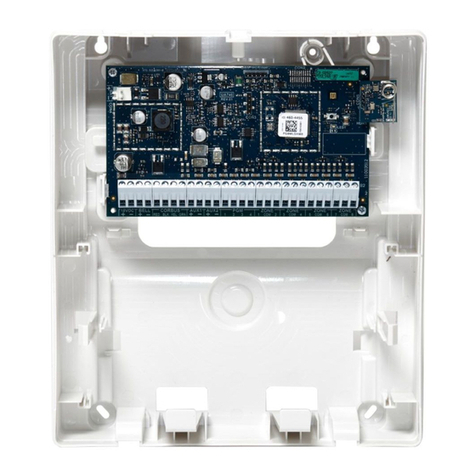
Johnson Controls
Johnson Controls tyco PG8WLSHW8 User manual

Johnson Controls
Johnson Controls FX-BTCVT Series User manual
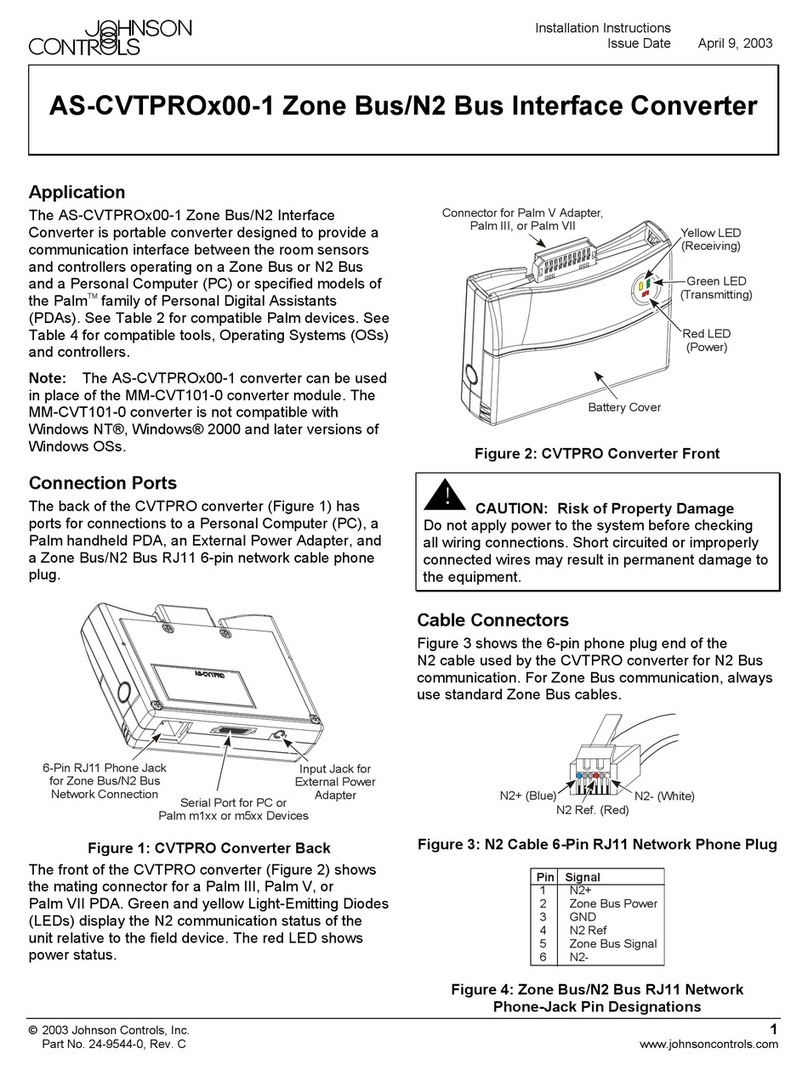
Johnson Controls
Johnson Controls AS-CVTPROx00-1 User manual

Johnson Controls
Johnson Controls Metasys BTCVT User manual
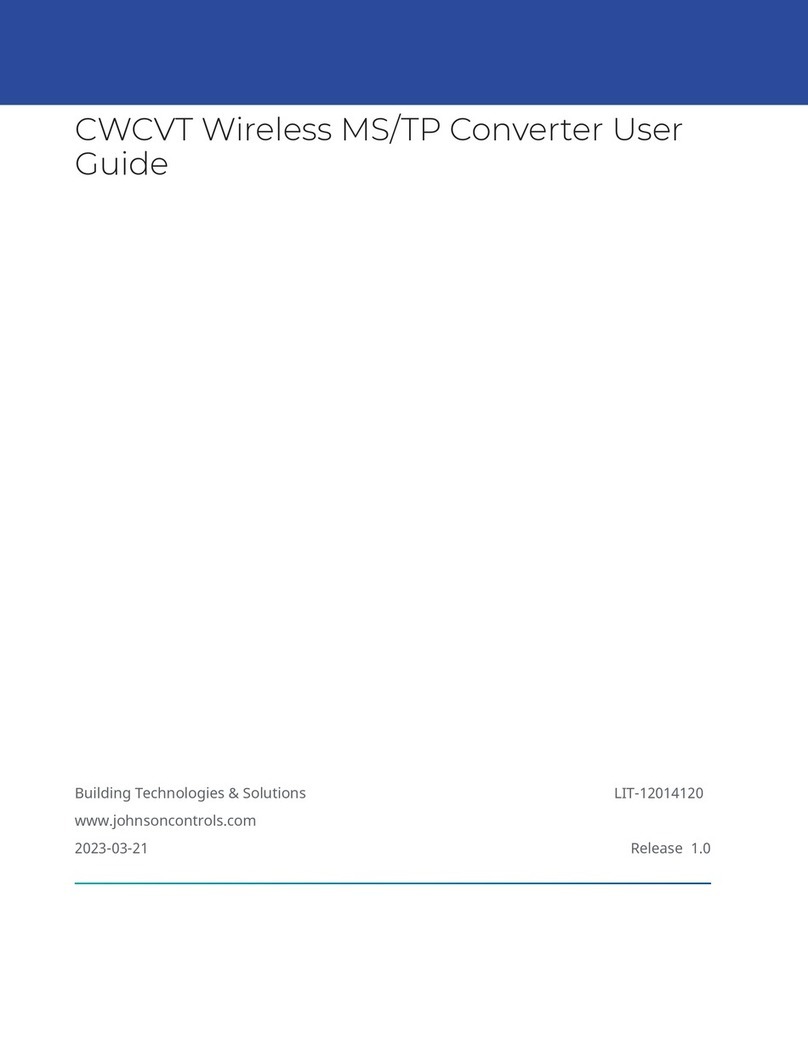
Johnson Controls
Johnson Controls CWCVT User manual

Johnson Controls
Johnson Controls FX-BTCVT User manual
